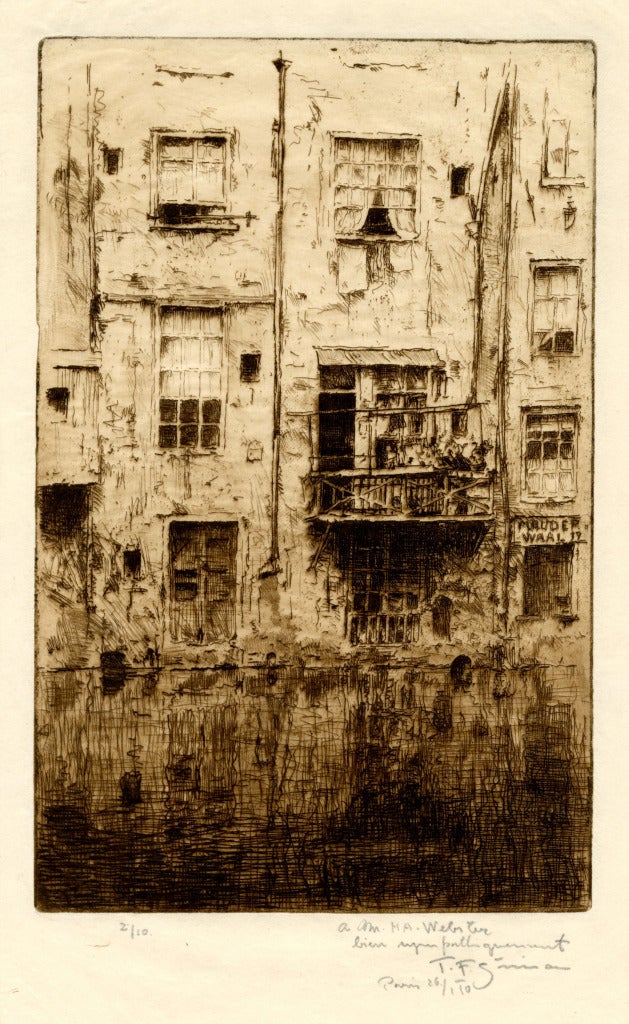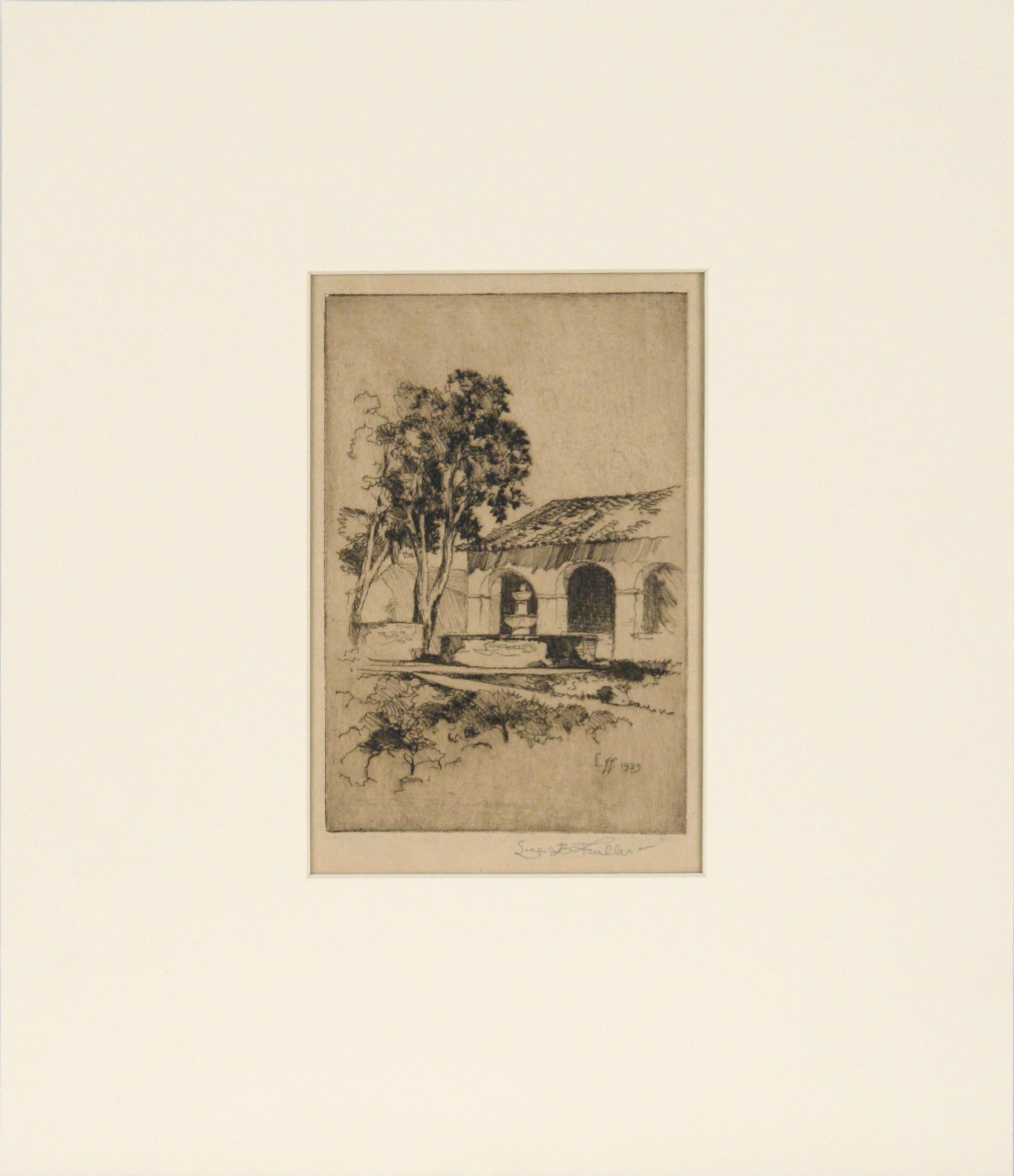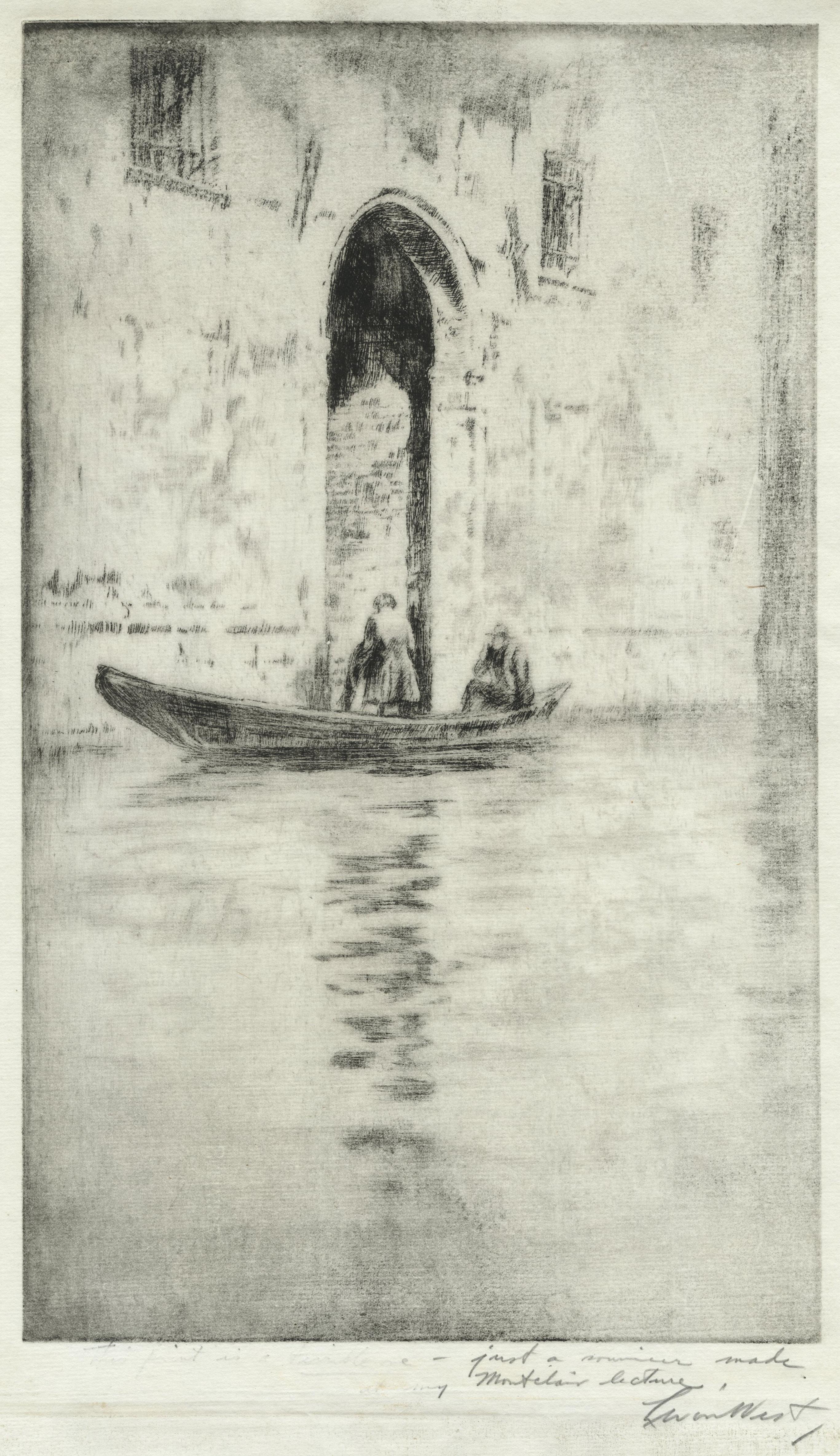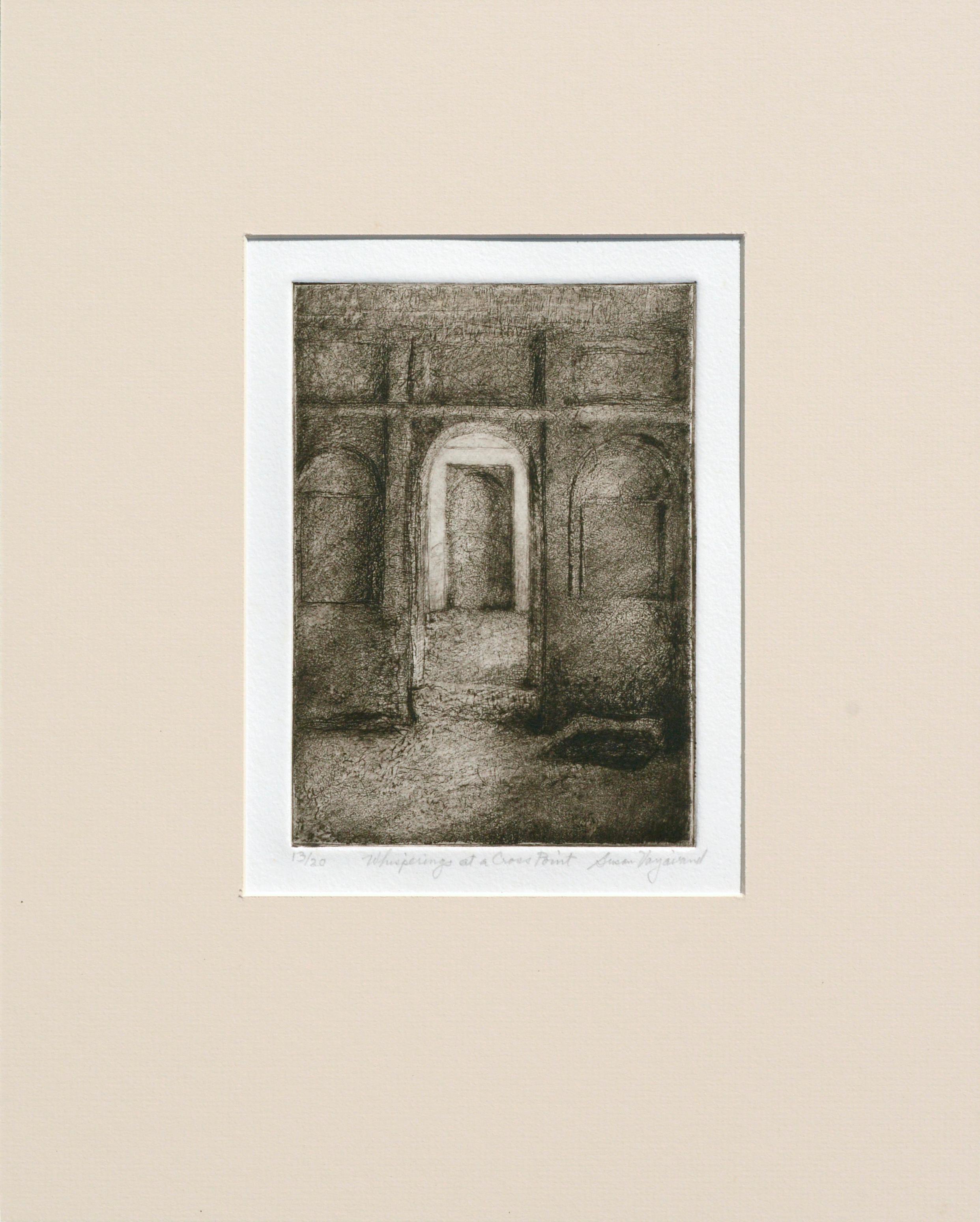Items Similar to Grand Central, Night
Want more images or videos?
Request additional images or videos from the seller
1 of 3
Walter TittleGrand Central, Nightc. 1920s
c. 1920s
About the Item
Walter Tittle, 'Grand Central Night', drypoint, edition not stated, c. 1920s. Signed in pencil. Titled, and annotated '36.00' and with the inventory number 'G2155' in pencil, in the bottom left sheet edge. A superb, luminous impression, on cream wove paper, with full margins (1 3/8 to 2 1/2 inches), in excellent condition. Matted to museum standards, unframed.
This evocative New York City nocturne depicts East 42nd Street, with Grand Central Station on the left, during the glamorous 1920s.
An impression of this work is in the permanent collection of the Carnegie Museum of Art.
- Creator:Walter Tittle (1883 - 1966, American)
- Creation Year:c. 1920s
- Dimensions:Height: 12.88 in (32.72 cm)Width: 7.88 in (20.02 cm)
- Medium:
- Movement & Style:
- Period:
- Condition:
- Gallery Location:Myrtle Beach, SC
- Reference Number:
About the Seller
5.0
Recognized Seller
These prestigious sellers are industry leaders and represent the highest echelon for item quality and design.
Platinum Seller
These expertly vetted sellers are 1stDibs' most experienced sellers and are rated highest by our customers.
Established in 1995
1stDibs seller since 2016
259 sales on 1stDibs
Typical response time: 1 hour
Associations
International Fine Print Dealers Association
- ShippingRetrieving quote...Ships From: Myrtle Beach, SC
- Return PolicyA return for this item may be initiated within 7 days of delivery.
More From This SellerView All
- The Plaza, Sunset GlowBy Walter TittleLocated in Myrtle Beach, SC'The Plaza, Sunset Glow', drypoint, c. 1920s, edition not stated. Signed in pencil and initialed in the plate, lower right. Titled 'The Plaza, Sunset' and annotated 'no. 165' in ink, in the bottom left sheet corner. A superb, luminous impression in dark brown ink, with selectively wiped plate tone; on cream wove paper; the full sheet with margins (1 to 2 1/4 inches). Pale tape stains on the top sheet edge, recto, well away from the image, otherwise in excellent condition. Matted to museum standards, unframed. A view across 'The Pond' in New York City's Central Park, toward Grand Army Plaza...Category
1920s American Impressionist Landscape Prints
MaterialsDrypoint
- 'Black Hawk Country' — Early 20th-Century American ImpressionismLocated in Myrtle Beach, SCRalph M. Pearson, 'Black Hawk Country', etching, second state, edition not stated, 1912. Signed, and titled in pencil. Inscribed 'Rock River Series Second...Category
1910s American Impressionist Landscape Prints
MaterialsEtching
- 'Ship Rock, New Mexico' —By Albert GrollLocated in Myrtle Beach, SCAlbert Lorey Groll, 'Ship Rock, New Mexico', etching, c. 1910. Signed and titled in pencil. A fine, richly-inked impression on cream, wove paper, the full sheet with margins (1 to 1 3/8 inches); a slight paper defect in the center-left margin, away from the image, otherwise in excellent condition. Image size 7 7/8 x 10 inches (200 x 254 mm); sheet size 10 1/8 x 12 15/16 inches (257 x 329 mm). Scarce. Provenance: Ex. collection Kennedy Galleries, in their original gallery mat with label attached. ABOUT THE ARTIST Albert Lorey Groll (1866-1910) was born in New York in 1866, the son of a pharmacist immigrant from Darmstadt, Germany. During his early years, he traveled to Europe to study at the Royal Academy of Fine Arts in Munich under Nicholas Gysis and Ludwig von Löfftz. He further pursued his studies in London and at the Royal Academy of Fine Arts in Antwerp, Belgium. Groll returned to New York in 1895 and moved from figure to landscape painting while expanding his interests to printmaking. In 1904 Groll made the first of several trips to the American Southwest, traveling to Arizona with ethnographer Stewart Culin of the Brooklyn Museum. Later he went to New Mexico with his friend, the artist and illustrator William Robinson Leigh (see our 1stDibs listing no. LU53239015112 ). He focused on impressionistic scenes of Native American lands. The Laguna Pueblo people admired Groll's paintings, honoring him with the name "Chief Bald Head Eagle Eye." Groll kept a studio in the Gainsborough Studios in Manhattan and won several awards for his work in Arizona and New York, including the Salmagundi Club Shaw Prize in 1904 and a gold medal at the Pennsylvania Academy of Fine Arts in 1906. He was also awarded the George Inness gold medal from the National Academy of Design in 1912 for his painting of Lake Louise in the Canadian Rockies. In 1910 he was elected into the National Academy of Design and, in 1919, an associate member of the Taos Society...Category
1910s American Impressionist Landscape Prints
MaterialsEtching
- 'Skaters' — 1930s Woodstock, New YorkBy Emil GansoLocated in Myrtle Beach, SCEmil Ganso, 'Skaters', pochoir (color stencil) with hand painting, edition c. 50, 1938, Smith S-6. Signed in the image, lower right. A rich, painterly impression, with fresh colors, on buff wove paper; the full sheet with margins (7/8 to 1 7/8 inches), in excellent condition. Matted to museum standards, unframed. Image size 11 3/4 x 15 1/4 inches; sheet size 18 3/4 x 13 3/4 inches. An impression of this work is in the permanent collection of the Philadelphia Museum of Art. ABOUT THE ARTIST Born in Germany, Emil Ganso (1895-1941) came to the United States with his family in 1912. After settling in New York City, he found night work in a bakery and concentrated on his art in the daytime—mostly self-taught at this time, he studied only briefly at the National Academy of Design. In 1924, Ganso showed his drawings to Carl Zigrosser, who organized the artist’s first solo exhibition, at the Weyhe Gallery. Soon afterward, Ganso enrolled in Eugene Fitsch’s printmaking class at the Art Students League. Although he considered himself primarily a painter, Ganso made prints in all media, including relief and stencil prints and complex intaglios, and even experimented with color lithography in the late 1920s. He also developed, with an engineer, the design and fabrication of an innovative etching press. In 1926, Ganso attended the Art Students League summer session in Woodstock, New York. There, he met Jules Pascin, and the two artists began a close friendship, briefly sharing a studio. Ganso followed Pascin to Europe in 1928. In 1929, Ganso returned to New York and showed his work regularly in group exhibitions. He continued working in Woodstock in the summer months, often printing lithographs for other artists. The Cleveland Print Club...Category
1930s American Impressionist Landscape Prints
MaterialsGouache, Stencil
- St. Paul's Church (St. Paul's Chapel, New York City)By Bror Julius Olsson NordfeldtLocated in Myrtle Beach, SCB.J.O. Nordfeldt, 'St. Paul's Church' (St. Pauls' Chapel), etching, edition not stated, c. 1915. Signed in pencil. A superb, richly-inked impression, with skillfully controlled plate tone, printed on off-white, antique, laid paper; the full sheet with margins (5/8 to 2 1/4 inches), in very good condition. Scarce. Matted to museum standards, unframed. An impression of this work is in the permanent collection of the Smithsonian American Art Museum. ABOUT THE ARTIST A solo exhibition of Nordfeldt’s etchings and woodcuts was presented by the Smithsonian Institution in 1926. In 1920, Nordfeldt had a one-man show at the Chicago Arts Club. In 1926, he won the bronze medal at the sesquicentennial exposition in Philadelphia and the Logan Medal at the Art Institute of Chicago. In 1927, he won the first annual prize from the Brooklyn Society of Etchers, and the following year he won first prize from the Chicago Society of Etchers. In 1929, Nordfeldt had a one-man show at the Denver Art Museum. Nordfeldt's work is held in numerous museum collections including Amon Carter Museum of Western Art, Ft. Worth; Anschutz Collection, Denver; Art Institute of Chicago; Biblioteque d’Art et d’Archeologie, Paris; British Museum, London; Corcoran Gallery of Art, Washington, DC; Los Angeles County Museum; Metropolitan Museum of Art, New York City; Museum of Fine Arts, Santa Fe; National Museum of American Art, Smithsonian Institution, Washington, DC; National Gallery, Sydney, Australia; Phillips Collection, Washington, DC. ABOUT ST. PAUL'S CHAPEL St. Paul's Chapel, nicknamed "The Little Chapel That Stood", is an Episcopal chapel located at 209 Broadway, between Fulton Street and Vesey Street, in Lower Manhattan, New York City. Built in 1766, it is the oldest surviving church building in Manhattan, and one of the nation's finest examples of Late Georgian church architecture. It is a New York City Landmark and a National Historic Landmark. The Hearts of Oak, a militia unit organized early in the American Revolutionary War, and composed in part of King's College (later, Columbia University) students, would drill in the Chapel's yard before classes nearby. Alexander Hamilton was an officer of this unit. The chapel survived the Great New York City Fire of 1776 when a quarter of New York City (then confined to the lower tip of Manhattan), including Trinity Church, burned following the British capture of the city after the Battle of Long Island during the American Revolutionary War. George Washington, along with members of the United States Congress, worshipped at St. Paul's Chapel on his Inauguration Day, April 30, 1789. Washington also attended services at St. Paul's during the two years New York City was the country's capital. Above Washington's pew is an 18th-century oil painting of the Great Seal of the United States, adopted in 1782. The rear of St. Paul's Chapel faces Church Street, opposite the east side of the World Trade Center site. After the attacks on September 11, 2001, which led to the collapse of the twin towers of the World Trade Center, St. Paul's Chapel served as a place of rest and refuge for recovery workers at the WTC site. For eight months, hundreds of volunteers worked 12-hour shifts around the clock, serving meals, making beds, counseling and praying with firefighters, construction workers, police, and others. Massage therapists, chiropractors, podiatrists, and musicians also tended to their needs. The church survived without even a broken window. Church history declares it was spared by a miracle sycamore on the northwest corner of the property that was hit by debris. The tree's root has been preserved in a bronze memorial...Category
1910s American Impressionist Landscape Prints
MaterialsEtching
- ShippingBy Kerr EbyLocated in Myrtle Beach, SCKerr Eby 'Shipping' also 'Shipping, Connecticut', etching and sandpaper ground, 1932, edition 100, Giardina 171. Signed in pencil and titled 'Shipping' in the bottom left sheet edge. A superb, atmospheric impression, with skillfully controlled plate tone, on heavy, cream wove paper; the full sheet with wide margins (2 to 2 3/4 inches), in excellent condition. Matted to museum standards, unframed. Image size 8 3/8 x 17 1/4 inches (316 x 176 mm); sheet size 13 7/16 x 8 3/8 inches (341 x 213 mm). The scene depicted was on the Connecticut coast...Category
1940s American Impressionist Landscape Prints
MaterialsEtching
You May Also Like
- Old Houses in AmsterdamBy T.F. SimonLocated in Fairlawn, OHOld Houses in Amsterdam Drypoint, 1909 Signed and dedicated in pencil lower right. "A Mr. H. A. Webster, bien sympathiquement, T.F. Simon, Paris 26/10" Simon...Category
Early 1900s American Impressionist Prints and Multiples
MaterialsDrypoint
- Palm Springs Courtyard with Fountain - Drypoint Etching on PaperLocated in Soquel, CAPalm Springs Courtyard with Fountain - Drypoint Etching on Paper Stately drypoint etching of the courtyard of a Palm Springs house by Leland "Lee" Fuller (American, 1899-1962). The focus of this piece is the courtyard of a house with a fountain. Behind the garden and fountain, there is a section of the house with an arched doorway and tile roof. This was likely a house that Fuller designed. From the Robert Azensky Fine Art Mary Pickford...Category
1920s American Impressionist Landscape Prints
MaterialsPaper, Ink, Drypoint
- "St. Nicolas du Chardonnet" Etching in Ink on PaperLocated in Soquel, CA"St. Nicolas du Chardonnet" Etching in Ink on Paper Delicate and detailed etching by Katherine Kimball (American, 1866-1949). The Catholic church of St. Nicolas du Chardonnet is shown nestled in the streets of Paris. With clever use of line weight and clarity, the building is highlighted and cleanly stands out against the background and surroundings. Stamp with coat of arms on verso. Artist's info written on verso. Presented in a new black mat with foamcore backing. Mat size: 16"H x 12"W Paper size: 10.75"H x 6.75"W Katherine Kimball (American, 1866-1949) was born in Fitzwilliam, New Hampshire. She studied at the National Academy of Design in New York and exhibited in the San Francisco Panama-Pacific Exhibition of 1915. Listed in “Who Was Who in American Art, 1564-1975”; “North American Women Artists...Category
1910s American Impressionist Landscape Prints
MaterialsPaper, Ink, Drypoint
- Untitled (Venice canal, man departing the gondola)By Levon WestLocated in Fairlawn, OHUntitled (Venice canal, man departing the gondola) Drypoint, c. 1930-1931 Signed in pencil lower right (see photo) Annotated in the lower margin: "Just a souvenir made ___ Monclair Lecture" Levon West In a supplemental list prepared by Otto Torrington he lists seven views of Venice. No edition of these Vencie images was ever printed. Only rare proof exist. I cannot find another impression of this image on line or in reference books. Condition: Very good impression with selective inking to the plate. Imperfections on the bottom edge of the sheet. Image/Plate size: 14 5/16 x 8 3/8 inches Sheet size: 17 1/2 x 11 1/2 inches Also known as Ivan Dmitri, Levon West gained international fame for his portrayals in color photography, etchings and watercolors. During his youth, West moved throughout North Dakota, as his father was a congressional preacher. After graduating from high school he taught school for a year and enlisted in the United States Navy. West was the recipient of a scholarship to the University of...Category
1930s American Impressionist Landscape Prints
MaterialsDrypoint
- Here They Come !By Frank W. BensonLocated in New York, NYThis impression of "Here They Come !" is from the fourth state of eight. There are six known impressions of the fourth state. Edition 150 (final state). It is signed in pencil in the lower left and inscribed "D-1". The image size 13 7/8 x 11 3/4" (34.6 x 28.8 cm) and sheet size 16 3/4 x 14 5/8" (42.8 x 37.1 cm). FRANK W. BENSON (1862-1951) Frank Weston Benson, well known for his American impressionist paintings, also produced an incredible body of prints - etchings, drypoints, and a few lithographs. Born and raised on the North Shore of Massachusetts, Benson, a natural outdoorsman, grew up sailing, fishing, and hunting. From a young age, he was fascinated with drawing and birding – this keen interest continued throughout his life. His first art instruction was with Otto Grundman at the Museum of Fine Arts in Boston, and then in 1883 in Paris at the Academie Julian where he studied the rigorous ‘ecole des beaux arts’ approach to drawing and painting for two years. During the early 1880’s Seymour Haden visited Boston giving a series of lectures on etching. This introduction to the European etching...Category
1920s American Impressionist More Prints
MaterialsDrypoint
- "Whisperings at a Cross Point" - Doorway Arch Drypoint EtchingBy Susan VarjavandLocated in Soquel, CACharming drypoint etching of a series of three arched interior doorways by Susan Varjavand (American, 1941-2018). Numbered, titled, and signed ("13/20 Whisperings at a Cross Point Susan Varjavand") along the bottom edge. Presented in a new cream mat. No frame. Image size: 14"H x 11"W Susan Varjavand (American, 1941-2018) was an artist from San Francisco, California. She studied with Patricia Pearce (American, b. 1948) while at the College of San Mateo, as well as with Richard Bowman (American, 1918-2001) and Alan May...Category
1980s American Impressionist Interior Prints
MaterialsPaper, Ink, Drypoint





